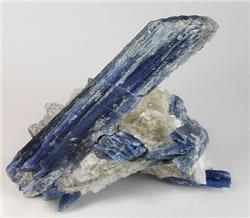Have you ever wondered about the different types of gemstones and why some are more valuable than others? Well, one factor that plays a significant role in a gemstone's value is whether it is anisotropic or isotropic. In this article, we will explore the differences between these two types of gemstones and discuss some of the most popular anisotropic gems.
Anisotropic Gems
Anisotropic gems are crystals whose refractive index changes depending on the direction in which light travels through them. This means that the optical properties of anisotropic gems, such as their color, brilliance, and transparency, can vary depending on the angle at which they are viewed.
One of the most popular anisotropic gems is cuprite, a dark red mineral that is often found in copper deposits. Cuprite is known for its deep red color and high refractive index, which gives it a bright and lustrous appearance when viewed from certain angles.
Covellite is another popular anisotropic gem that is prized for its deep blue color and metallic luster. This gemstone is often used in jewelry and has a hardness of around 3-3.5 on the Mohs Scale, making it suitable for everyday wear.

Kyanite is another well-known anisotropic gemstone that comes in a range of colors, including blue, green, and black. This gemstone has a unique property known as "pleochroism," which means that it can appear different colors depending on the angle at which it is viewed.

Isotropic Gems
In contrast to anisotropic gems, isotropic gems have a constant refractive index regardless of the direction in which light passes through them. This means that isotropic gems, such as diamonds and garnets, have a uniform appearance from all angles.
Diamonds are perhaps the most well-known isotropic gemstones and are prized for their brilliant sparkle and unparalleled hardness. This gemstone has a refractive index of 2.42, which gives it its distinctive fire and luster.

Garnets are another popular isotropic gemstone that come in a variety of colors. This gemstone has a refractive index of 1.76-1.84 and is often used as a substitute for other precious stones.

Introduction to Gemstones
For centuries, gemstones have been prized for their beauty, rarity, and symbolic value. Gemstones are minerals or organic materials that are cut and polished to create jewelry or other decorative items. The history of gemstones dates back to ancient times, when they were used as currency, religious offerings, and symbols of power and status.
Today, gemstones are still highly prized for their beauty and value. Some of the most popular gemstones include diamonds, rubies, emeralds, sapphires, and pearls. Each type of gemstone has its own unique properties, including color, hardness, and transparency.
About Anisotropic and Isotropic Gemstones
The difference between anisotropic and isotropic gemstones lies in their optical properties. Anisotropic gemstones have a refractive index that varies depending on the direction of light passing through them, while isotropic gemstones have a constant refractive index regardless of the direction of light.
This difference in optical properties can affect the appearance of a gemstone, making anisotropic gems more desirable in some cases. Anisotropic gems may have a unique play of color or a sparkling luster that is not found in isotropic gems.
Frequently Asked Questions
What are some common anisotropic gemstones?
Some common anisotropic gemstones include cuprite, covellite, and kyanite.
Are anisotropic or isotropic gemstones more valuable?
The value of a gemstone is based on many factors, including its rarity, beauty, and demand. Anisotropic and isotropic gemstones can both be valuable depending on their specific properties and the preferences of buyers.
Can anisotropic and isotropic gemstones be used together in jewelry?
Yes, anisotropic and isotropic gemstones can be used together in jewelry to create interesting contrasts and textures. However, it is important to consider the optical properties of each stone to ensure that they complement each other well.
How can I tell if a gemstone is anisotropic or isotropic?
The easiest way to determine whether a gemstone is anisotropic or isotropic is to observe its refractive index. Anisotropic gemstones will have two or more refractive indices, while isotropic gemstones will have a single refractive index.
In conclusion, anisotropic and isotropic gemstones have different optical properties that can affect their appearance and value. Anisotropic gems, such as cuprite and kyanite, are prized for their unique play of color and luster, while isotropic gems, such as diamonds and garnets, have a uniform appearance from all angles. Both types of gemstones can be valuable depending on their specific properties and the preferences of buyers.